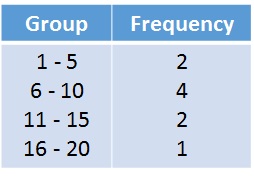Grouped Frequency Tables
(KS3, Year 7)

Understanding the Grouped Frequency Table
Rather than showing how many times each number appears in a list of numbers (like a frequency table), a grouped frequency table groups the numbers in the list into different groups, and tells you how many times numbers from within each group appear in the list. Let's look again at our list of numbers (rearranged in order and each group of numbers counted):
-
We see that there are 2 numbers that appear in the 1 - 5 group (2 and 5).
We write 1 - 5 in the Group column.
We write 2 in the Frequency column because numbers in the 1 - 5 range appear 2 times in the list of numbers.

-
We see that there are 4 numbers in the 6 - 10 group (7, 8, 9 and 10).
We write 6 - 10 in the Group column.
We write 4 in the Frequency column because numbers in the 6 - 10 range appear 4 times in the list of numbers.


Finding Averages from a Grouped Frequency Table
The grouped frequency table can be used to find the average of a set of numbers. A grouped frequency table can be used to find the mean, the median group and the mode group.Other Types of Frequency Table
-
A frequency table shows how often (how frequently) each number appears in a list of numbers.

-
A cumulative frequency table has another column which keeps a running total of the frequencies.

-
A cumulative grouped frequency table is a grouped frequency table that has another column which keeps a running total of the frequencies.

Top Tip
Grouped Frequency Tables Are for Continuous Data
A grouped frequency table is for continuous data. Continuous data can take any value (within a range). For example, it may take any value from 1 - 10: 1.5, 2.31, 3.05. This is unlike discrete data, which can only take certain values. For example: 1, 2, 3. It can't take values in between these values: it can't take 1.5.Note
What's in a Name?
"Frequency" means how often something occurs.Other Column Headings
In the frequency table, the column headings are Group and Frequency. This needn't be the case. Each group is a grouping of numbers. The numbers could represent many things: test scores, incomes, heights, number of pets. Use a descriptive heading in the frequency table (Score, Income, Height, No. of pets).Worksheet
This test is printable and sendable






